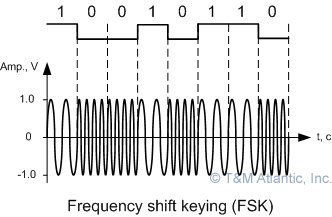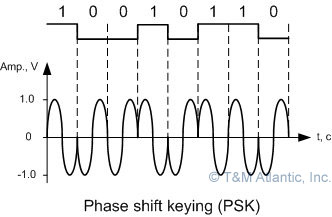Journey of digital modulation techniques
- Vinay Hajare
- Nov 17, 2024
- 5 min read

Digital modulation has been instrumental in the evolution of modern telecommunications. This journey from simple binary encoding to complex, multi-symbol techniques has revolutionized how data is transmitted over vast distances. This blog delves into the timeline and advancements in digital modulation, exploring significant years and technological milestones that have shaped today’s communications landscape.
Digital modulation is a process that alters a carrier wave's properties to encode digital data. By modifying aspects of the carrier wave such as amplitude, frequency, and phase, digital modulation allows binary data to be transmitted over various media, from copper wires to fiber optics and the radio-waves.
Why?
Digital modulation methods improve signal clarity, reduce interference, and allow higher data transfer rates. These techniques are central to wireless communication standards, broadband, and satellite networks.
From Analog to Digital: The Early Shifts (1950s - 1970s)
The shift from analog to digital modulation began as telecommunications systems started transitioning to digital methods in the 1950s and 1960s. The growth of computer technology and the need for efficient, noise-resistant communication methods led to the first uses of digital signaling.
Pulse Code Modulation (PCM), invented by Alec Reeves in 1937, PCM was one of the first digital techniques, converting analog signals into digital binary signals. This laid the foundation for digital voice communication.

In the 1960s, digital communication methods began to see limited deployment in military applications due to their resilience to noise and signal attenuation.
The Foundation of Digital Modulation Techniques (1970s - 1980s)
The 1970s and 1980s saw the development and adoption of fundamental digital modulation techniques. Here are some of the earliest digital modulation methods that formed the backbone of digital communication.
Amplitude Shift Keying (ASK): ASK modulates the amplitude of the carrier wave to represent binary data. It was among the earliest techniques, though it was prone to noise and interference.

Frequency Shift Keying (FSK): Introduced in the 1970s, FSK became popular for its improved noise resistance over ASK. In FSK, different frequencies represent binary values, making it suitable for early data transmission over noisy lines.

Phase Shift Keying (PSK): PSK uses shifts in the phase of the carrier signal to encode data. With improvements over ASK and FSK in terms of bandwidth efficiency, PSK became a popular choice by the late 1970s, especially in military and early satellite communications.

Key Year - In 1979, Japan launches the first commercial cellular network, marking a breakthrough in mobile communications and a new era for digital modulation techniques.
Advances in Efficiency: The Rise of Complex Modulation (1980s - 1990s)
The 1980s saw rapid development in digital communication as demand for higher data rates increased. This led to the refinement of PSK and the introduction of new, more complex techniques.
Quadrature Phase Shift Keying (QPSK): By encoding two bits per symbol, QPSK doubled the data rate of PSK without requiring additional bandwidth, making it ideal for early satellite and cellular networks.
Quadrature Amplitude Modulation (QAM): Combining ASK and PSK, QAM enabled even higher data rates by encoding multiple bits per symbol. By the 1990s, 16-QAM and 64-QAM became popular in digital broadcasting, allowing efficient use of available bandwidth.

Key Years:
1982: The Global System for Mobile Communications (GSM) is introduced, using digital modulation for mobile communication standards.
1991: The U.S. launches the first GSM network, standardizing digital modulation in mobile communication worldwide.
Enhanced Data Rates: The Broadband Era and Modern Modulation (2000s)
As the internet expanded globally in the 2000s, the need for faster, more efficient data transmission led to the adoption of Orthogonal Frequency Division Multiplexing (OFDM) and other advanced techniques.
Orthogonal Frequency Division Multiplexing (OFDM): By splitting data across multiple closely spaced carriers, OFDM became the standard for broadband communication, including Wi-Fi, LTE, and later 5G. It allowed more data to be packed into limited bandwidth, with high resistance to interference and fading.

Key Years:
1999: Wi-Fi networks begin using OFDM for faster data rates and reduced interference.
2008: The Long-Term Evolution (LTE) standard incorporates OFDM for high-speed mobile data, setting the stage for 4G networks
The Present and Future: Digital Modulation in 5G and Beyond (2010s - Present)
With the advent of 5G technology, digital modulation has become more complex, incorporating adaptive techniques to maximize data rates, reduce latency, and improve reliability.
Massive MIMO and Beamforming: Combined with digital modulation, these techniques increase signal capacity and reliability in 5G networks.

Higher Order QAM (e.g., 256-QAM, 1024-QAM): Newer QAM levels are employed in 5G to maximize data rates while maintaining robustness against interference.
Key Year - 2019: 5G networks begin rolling out globally, offering unprecedented data rates and latency improvements through enhanced modulation techniques.
The journey of digital modulation has been marked by continuous advancements, each addressing the growing demand for faster, clearer, and more reliable data transmission. From the early days of PCM and ASK to the sophisticated, adaptive techniques in today’s 5G networks, digital modulation techniques continue to be the driving force behind the interconnected world.
Frequently Asked Questions (FAQs)
1. What is digital modulation, and how does it differ from analog modulation?
Digital modulation is a technique used to encode digital data (binary 0s and 1s) onto a carrier wave by altering its properties, such as amplitude, frequency, or phase. Unlike analog modulation, which uses continuous signal variation to represent data, digital modulation represents discrete binary information, allowing for clearer, more reliable communication, especially over long distances.
2. What are the main types of digital modulation techniques?
The primary digital modulation techniques include:
Amplitude Shift Keying (ASK): Changes the amplitude to represent binary values.
Frequency Shift Keying (FSK): Modulates frequency for binary encoding.
Phase Shift Keying (PSK): Alters phase to encode data.
Quadrature Amplitude Modulation (QAM): Combines amplitude and phase modulation for higher data rates.
Each type has its advantages and is suited to different environments and data requirements.
3. Why was the shift from analog to digital modulation significant?
Digital modulation offers improved noise immunity, allowing clearer data transmission with less interference. It also supports higher data rates, efficient use of bandwidth, and compatibility with digital computing and storage systems, which were key to advancing modern communication technologies.
4. What is Quadrature Amplitude Modulation (QAM), and why is it widely used?
QAM combines aspects of amplitude and phase modulation, encoding multiple bits per symbol, which enables higher data transfer rates. This makes it ideal for applications like digital television, cable modems, and cellular networks where bandwidth efficiency is crucial.
5. How did OFDM change digital communication?
Orthogonal Frequency Division Multiplexing (OFDM) divides a signal across multiple, closely spaced sub-carriers, making it highly efficient and resilient to interference and multi-path fading. OFDM is foundational in broadband technologies like Wi-Fi, LTE, and 5G due to its ability to support high-speed data in crowded frequency bands.
6. How do newer technologies like 5G use digital modulation?
5G networks use higher-order QAM (e.g., 256-QAM, 1024-QAM) and incorporate advanced techniques like Massive MIMO (Multiple Input Multiple Output) and beamforming to optimize data rates, reduce latency, and enhance reliability. These modulation methods ensure 5G can support faster connections, greater capacity, and more devices simultaneously.
7. What is the future of digital modulation?
Future modulation techniques may focus on adaptive modulation, allowing dynamic changes to modulation schemes based on network conditions. This adaptability is essential for the next generation of 5G and 6G networks, as well as the Internet of Things (IoT), where a variety of devices will require efficient, reliable communication under diverse conditions.






Comments